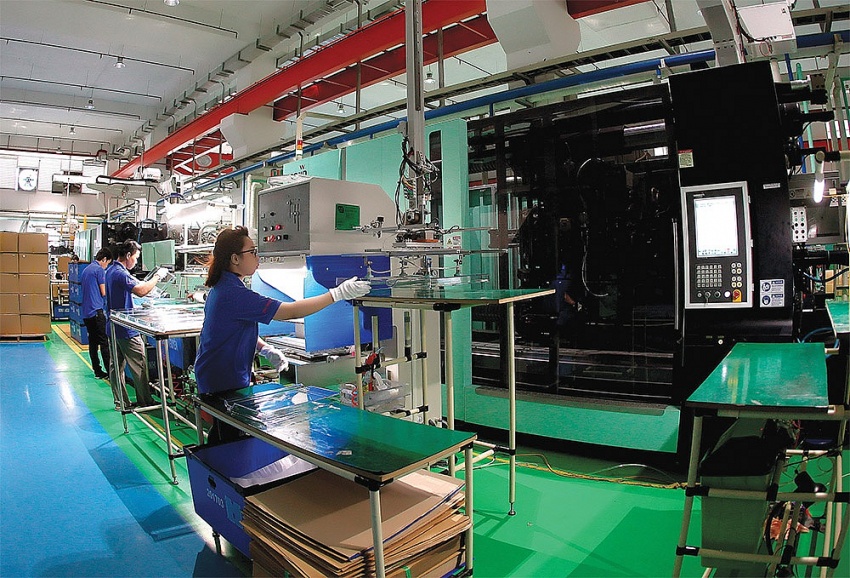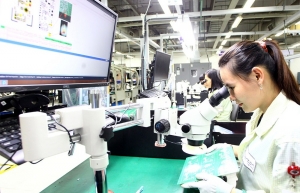Key driver gains a must for growth
According to the World Bank’s biannual economic update report released last week, it is expected that the Vietnamese economy may grow by 5.5 per cent this year and 6 per cent next year, making it among top growth leaders in the world.
This is still lower than the government’s target of 6.5 per cent this year.
“One of the largest drivers of the growth is the manufacturing and processing industry, which is gradually bouncing back but still slow,” said Dorsati Madani, senior country economist at the World Bank in Vietnam.
The World Bank stated that after experiencing a slowdown in 2023, the economy is showing mixed signs of recovery in early 2024. While exports are recovering, consumption and private domestic investment are growing more gradually. Real exports are expected to grow by 3.5 per cent in 2024, reflecting gradual improvement in global demand.
“In addition, a turnaround in the real estate sector is anticipated later this year and next, bolstering domestic demand as investors and consumers regain confidence. Real total investment and private consumption are projected to increase by 5.5 and 5 per cent in 2024, respectively,” said the World Bank.
 |
Under the General Statistics Office’s Q1 survey over 50,000 manufacturing and processing enterprises in Vietnam released last week, it is expected that 45.4 per cent of respondents believe their Q2 performance will be “better than in Q1”; 36.6 per cent said their production and business landscape will be “stable” in Q2; and only 18 per cent project their performance will be “more difficult” in Q2.
The most optimistic business groups include foreign-invested enterprises and domestic private enterprises, in which 82.2 per cent of both types of businesses project their Q2 performance will be “better than” and “more stable than” in Q1. The rate of state-owned enterprises stood at 78.1 per cent.
When it comes to Q2 production output, 44.1 per cent of respondents project their output will be higher than in Q1; 38.2 per cent predict their output will be stable; and only 17.7 believe they will face a reduction.
As for Q2 orders, 42.2 per cent of surveyed enterprises forecast that their orders will be higher than in Q1; 40.7 per cent said they will have stable orders; and only 17.1 per cent hold that they will see a decrease in Q2 orders.
“The gradual return of new orders and consumption revived manufacturing growth at the end of 2023, with the trend gaining further momentum in 2024,” the Asian Development Bank (ADB) stated in its latest economic updates released more than a week ago.
Under the ADB’s analysis, Vietnam’s manufacturing expanded at 6.8 per cent in the first quarter of 2024, compared with the contraction of 0.5 per cent a year ago, contributing to industrial growth of 6.3 per cent.
“Lower interest rates, fiscal measures supporting growth, and the recently improved land-related legal framework should support construction. However, slow global growth and still high global policy rates could weigh down export-led manufacturing growth,” the ADB said.
The ADB forecasts that the Vietnamese economy is expected to grow 6 per cent in 2024 and 6.2 per cent in 2025. A relatively broad-based growth restoration in export-led manufacturing, services, and stable agriculture would make the gradual recovery possible.
“Positive inflows of foreign investment and remittances, a sustained trade surplus, continued fiscal support, and a substantial public investment programme would also stimulate growth,” said Nguyen Ba Hung, principal country economist at the ADB in Vietnam.
The economy grew 5.66 per cent in the first quarter of this year, higher than the on-year rise of 3.41 and 5.12 per cent in the same periods of 2023 and 2022, respectively.
In the first three months, as compared to the same period last year, the processing and manufacturing sector which creates more than 80 per cent of industrial growth, ascended 6.98 per cent; while the mining sector declined 5.84 per cent; the electricity production and distribution sector expanded 11.97 per cent; and the sector of water supply and wastewater and waste treatment increased 5 per cent.
Figures from the Ministry of Planning and Investment showed that in March, nearly 14,100 businesses were newly established, up 64.3 per cent on-year.
In Q1 this year, Vietnam witnessed more than 36,200 enterprises of the type registered at $13.84 billion, using nearly 258,800 workers. This was up by 6.9 per cent in the number of enterprises, 7 per cent in registered capital, and 22 per cent in the number of employees – as compared to the same period last year.
If another $16.34 billion registered by 9,700 operational enterprises is included, the total capital supplemented into the economy in the period was $30.18 billion.
The European Chamber of Commerce in Vietnam’s (EuroCham) most recent Business Confidence Index, conducted by Decision Lab, has signalled optimism in Vietnam’s economy. The quarterly index reached 52.8 in Q1 2024 – its highest level since Q3 2022 – a clear sign of increased confidence within Vietnam’s European business community.
European businesses signal a strong likelihood of recommending Vietnam as a top investment destination. A significant 54 per cent of those surveyed indicated a high likelihood of recommending the country to other foreign businesses, giving ratings of 8 or above out of 10. Sentiment shifted positively for the upcoming quarter regarding the overall economy. Optimism is up six points from last quarter to 45 per cent, while pessimism is only 10 per cent. Additionally, over half of respondents anticipate higher orders and revenues in Q2 2024, and 40 per cent of businesses plan to expand their workforce in Q2.
Also, there has been a reduction of the number of firms planning to cut spending in Q2, now just 15 per cent compared to the previous 23 per cent, “indicates a boost in investment confidence.”
“This positive trend underscores the European business community’s view of Vietnam as a dynamic market with promising growth prospects,” said EuroCham chairman Dominik Meichle. “The index once again rising above the 50 threshold reaffirms the country’s growing appeal. Continued efforts to enhance stability and predictability will further strengthen Vietnam’s global competitiveness and unlock its full potential.”
Vietnam attracted close to $6.17 billion in foreign direct investment from the beginning of this year to March 20, up 13.4 per cent on-year.
| Prime Minister Pham Minh Chinh last week ordered the Ministry of Planning and Investment (MPI) to analyse, forecast, and advise the government on appropriate scenarios in order to promote growth associated with maintaining macroeconomic stability, controlling inflation, and supporting production and business activities. The MPI is also required to focus on promoting and attracting large-scale, high-tech foreign-invested projects, especially those for developing the digital economy, green economy, and circular economy, and engaging in the industries of processing, manufacturing, electronics, semiconductors, and hydrogen. The Ministry of Finance is ordered to research the extension of the tax payment deadline, reducing registration fees for domestically produced and assembled cars, and cutting the rental for land and water surface. Meanwhile, the Ministry of Industry and Trade is also requested to take measures to ensure sufficient supply of electricity, petrol, and oil. The PM ordered that the ministry has to avoid electricity and petrol shortages in all situations. The State Bank of Vietnam is also asked to continue to direct commercial banks to reduce lending rates, and take measures to manage credit growth and increase the economy’s ability to access capital. The central bank has also been ordered to boost the disbursement of a $5 billion credit package for investors and home buyers of social housing projects. |
 | ADB forecasts 6 per cent growth for Vietnam According to the Asian Development Outlook released by the Asian Development Bank (ADB) on April 11, slowing global demand and high international interest rates hampered Vietnam’s growth last year, yet Vietnam's economy is expected to grow 6 per cent in 2024 and 6.2 per cent in 2025. |
 | Sluggish growth and risks abound in banking arena A handful of banks have released their latest financial figures. Le Hoai An, a banking consultant and trainer at Integrated Financial Solutions, talked to VIR’s Hong Dung about the low profits for some, and potential risks in the industry. |
 | Accelerated public investment the backbone to new growth Vietnam is being advised by economists to have a bigger focus on boosting the expansion of fiscal policy to fuel domestic production and business activities. |
What the stars mean:
★ Poor ★ ★ Promising ★★★ Good ★★★★ Very good ★★★★★ Exceptional
Related Contents
Latest News
More News
- Vietnam's top 500 value-creating enterprises announced (December 27, 2025 | 08:00)
- The PAN Group shaping a better future with ESG strategy (December 26, 2025 | 09:00)
- Masan Consumer officially lists on HSX, marking the next phase of value creation (December 25, 2025 | 13:20)
- MCH to become the largest consumer stock on VN-Index (December 24, 2025 | 11:05)
- Oil and gas firms post strong 2025 results (December 22, 2025 | 17:42)
- SABECO wins multiple international beer awards (December 22, 2025 | 17:41)
- UOB sees Vietnam growth easing in fourth quarter (December 22, 2025 | 17:39)
- First members of Danang International Finance Centre revealed (December 22, 2025 | 17:39)
- Human-centred governance seen as key to AI development (December 19, 2025 | 18:19)
- Top 10 notable events of Vietnam’s industry and trade sector in 2025 (December 19, 2025 | 14:00)

 Tag:
Tag:




















 Mobile Version
Mobile Version